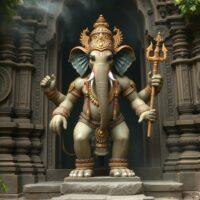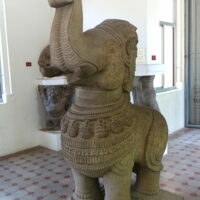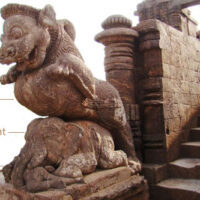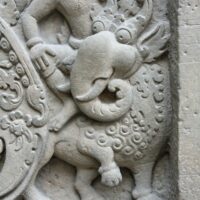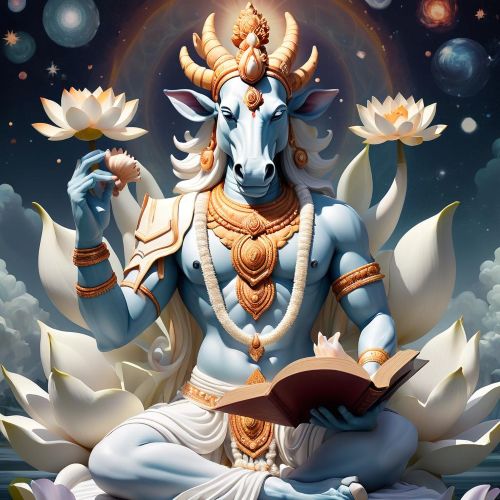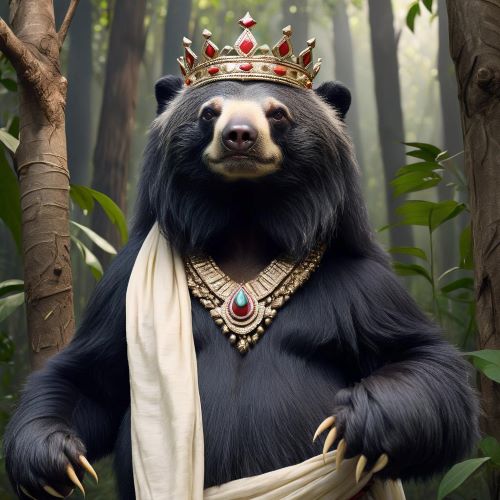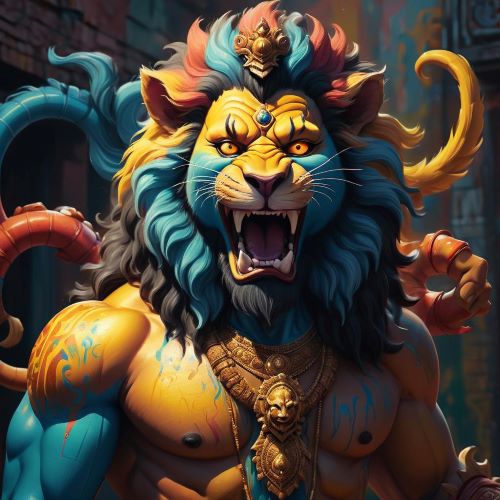Gajasimha : The Temple Protector
Listen
At a glance
| Description | |
|---|---|
| Origin | Indian Mythology |
| Classification | Hybrids |
| Family Members | N/A |
| Region | India, Cambodia, Thailand |
| Associated With | Temples, Protection |
Gajasimha
Introduction
The Gajasimha (Sanskrit: gaja = elephant, simha = lion) is one of the most intriguing mythological hybrids in South and Southeast Asian traditions. With the powerful body of a lion and the head or trunk of an elephant, it represents a union of might, wisdom, and divine authority. In Hindu mythology, the creature symbolizes guardianship and is often placed at the entrances of temples to ward off negative forces. Beyond India, the Gajasimha found its place in Cambodian and Thai art, where it became a heraldic emblem of royal and spiritual power.
This mythical figure is not simply ornamental; it conveys deeper cultural meanings of protection, sovereignty, and cosmic order. From its earliest depictions in Indian temple carvings to its presence in Khmer bas-reliefs and Thai royal seals, the Gajasimha has remained a powerful archetype that continues to influence both traditional and modern artistic expressions.
Physical Traits
The physical form of the Gajasimha blends two of the most revered animals in Indian and Southeast Asian culture: the lion and the elephant. The lion’s muscular body conveys agility, dominance, and royal courage, while the elephant’s head or trunk symbolizes wisdom, endurance, and divine strength.
In Indian art, Gajasimhas often appear carved into temple gateways, acting as guardians that protect sacred spaces. They are sometimes shown trampling foes beneath their feet, highlighting their role as defenders of dharma. Sculptures from Odisha and Madhya Pradesh present them with lifelike detail, reflecting the grandeur of lions combined with the serene strength of elephants.
Khmer art, particularly during the reign of Suryavarman II, emphasized more stylized depictions. Bas-reliefs at Angkor Wat portray Gajasimhas with scaled textures, elevating their image from terrestrial guardians to celestial protectors. In Thailand, the Gajasimha became a heraldic figure known for its symmetrical posture and elaborate detailing, often incorporated into Buddhist temple finials and military emblems. The hybrid’s appearance consistently conveys the message of balance: the ferocity of the lion harmonized with the wisdom of the elephant.
Family
Unlike gods or semi-divine beings, the Gajasimha does not have a genealogical family. Instead, it belongs to a symbolic lineage of hybrid guardians found across Hindu and Buddhist traditions. These beings embody protective and cosmic roles rather than biological relationships.
In Indian mythology, the Gajasimha is conceptually linked to other composite figures such as the Yali, a lion-based guardian with multiple animal features, and the Makara, a crocodile-like hybrid representing fertility and water. It also shares symbolic space with Airavata, the celestial elephant of Indra, who controls rain and fertility. Each of these mythic beings reflects an aspect of universal balance, making the Gajasimha part of a broader mythological taxonomy rather than an isolated entity.
Khmer interpretations closely associated the Gajasimha with Vishnu. During Suryavarman II’s reign, temple art often depicted Vishnu reclining with Gajasimhas in protective roles. This integration suggests that the creature symbolized not only protection but also divine kingship, reinforcing the ruler’s legitimacy as an earthly extension of divine order. Thus, the “family” of Gajasimha is not genealogical but symbolic, positioning it within a lineage of hybrid guardians central to Hindu and Buddhist cosmology.
Other names
The Gajasimha is known by several names across regions and traditions, reflecting linguistic shifts and cultural adaptations. In Sanskrit, it is often called Gaja-Simha, a direct reference to its elephant-lion form. In Pali, the variation Gajasiha appears in inscriptions and texts.
In South Indian temple architecture, sculptors sometimes referred to it as Gaja Vyāla, a category of hybrid guardians blending elephant and lion traits. Medieval Sanskrit poetry also mentions it as Gaja Śārdula, often as a metaphor for unconquerable power.
In Cambodia and Thailand, the hybrid became more heraldic in nature. Khmer inscriptions identified it with divine guardianship, while in Thailand it was popularly known as Kochasri, appearing in royal emblems and temple motifs. These variations demonstrate the creature’s adaptability across linguistic and cultural boundaries while retaining its essential symbolism of power, wisdom, and guardianship.
Powers and Abilities
The powers of the Gajasimha are symbolic rather than magical, yet they convey an extraordinary fusion of qualities. The elephant aspect bestows wisdom, memory, and the strength of divine sanction, while the lion contributes courage, dominance, and royal authority. Together, they embody the traits of an ideal ruler—brave yet wise, powerful yet just.
As temple guardians, Gajasimhas ward off malevolent forces and ensure the sanctity of sacred spaces. Their placement at gateways reflects their role as threshold protectors, keeping chaos outside while preserving spiritual harmony within. In Khmer cosmology, their presence in Vishnu’s mythological scenes symbolized the cosmic balance of power, replacing older serpent guardians like Ananta in certain contexts.
The creature’s imagery also carries metaphorical depth. In some Indian motifs, a lion is shown standing upon an elephant, representing triumph. This has been interpreted as a metaphor for spiritual energy (lion) overpowering material or sensual power (elephant). Classical Sanskrit poetry describes lions conquering elephants and obtaining “gajamauktikas” (mythical elephant pearls), which symbolized rare rewards achieved through victory.
Thus, the Gajasimha embodies not only protection and sovereignty but also the eternal struggle and harmony between opposing forces.
Modern Day Influence
Despite its ancient origins, the Gajasimha continues to shape modern cultural and artistic traditions. In India, it remains visible in temple architecture, particularly in historic sites like the Sun Temple of Konark and the Gwalior Fort, where it appears as a recurring motif of guardianship. In Cambodia, it features in structures such as Prasat Prei Kmeng, while Thailand continues to preserve it in Buddhist temple architecture.
Heraldically, the Gajasimha retained official importance into the modern era. In Siam (pre-modern Thailand), it served as the symbol of the Kalahom, one of the king’s chief chancellors, between 1873 and 1910. Cambodia officially adopted it into the Royal Arms in 1993, underscoring its enduring role as a national emblem of power and protection.
Modern public spaces also display Gajasimha statues, such as those at the Ministry of Defence in Thailand and at royal crematoriums like that of King Bhumibol Adulyadej. In India, motifs inspired by elephants and lions appeared prominently in global showcases like the G20 India 2023 summit, highlighting the continuity of these symbols in projecting cultural identity.
Beyond architecture and heraldry, Gajasimha has found a place in modern storytelling and digital art. It appears in video games, mythological databases, and AI-generated artworks, reflecting a renewed global fascination with hybrid creatures. Scholars and artists alike use Gajasimha as a lens for cross-cultural studies, examining how myths evolve and adapt across time and geography.
Its relevance also extends into philosophy and psychology. The symbolic interpretation of Gajasimha as a balance between wisdom and power, or between material and spiritual energy, continues to resonate in modern discourse on discipline, leadership, and self-mastery.
Related Images
Source
Bane, T. (2016). Encyclopedia of Beasts and Monsters in Myth, Legend and Folklore. McFarland. ISBN: 9780786495054
Da Nang City Tourism Information Portal. (n.d.). Gajasimha – Da Nang City Tourism Information Portal. https://danangfantasticity.com/en/danang-museum-of-cham-sculpture/gajasimha-2
inbrindavan.com. (2023, November 6). Yali, Navagunjara, GajaSimha and Makara.
Lucas Varro. (n.d.). Gajasimha – Lucas Varro. https://www.lucasvarro.com/portfolio/gajasimha/
Pattanaik, D. (2022, May 8). Lion Atop an Elephant – Devdutt Pattanaik.
Wikipedia. (n.d.). Gajasimha. https://en.wikipedia.org/wiki/Gajasimha
Wikipedia. (n.d.). List of hybrid creatures in folklore – Wikipedia. https://en.wikipedia.org/wiki/List_of_hybrid_creatures_in_folklore
Wikimedia Commons. (2018, December 21). Category:Gajasimha – Wikimedia Commons. https://commons.wikimedia.org/wiki/Category:Gajasimha
Frequently Asked Questions
What is lorem Ipsum?
I am text block. Click edit button to change this text. Lorem ipsum dolor sit amet, consectetur adipiscing elit. Ut elit tellus, luctus nec ullamcorper mattis, pulvinar dapibus leo.
What is lorem Ipsum?
I am text block. Click edit button to change this text. Lorem ipsum dolor sit amet, consectetur adipiscing elit. Ut elit tellus, luctus nec ullamcorper mattis, pulvinar dapibus leo.
What is lorem Ipsum?
I am text block. Click edit button to change this text. Lorem ipsum dolor sit amet, consectetur adipiscing elit. Ut elit tellus, luctus nec ullamcorper mattis, pulvinar dapibus leo.
What is lorem Ipsum?
I am text block. Click edit button to change this text. Lorem ipsum dolor sit amet, consectetur adipiscing elit. Ut elit tellus, luctus nec ullamcorper mattis, pulvinar dapibus leo.
What is lorem Ipsum?
I am text block. Click edit button to change this text. Lorem ipsum dolor sit amet, consectetur adipiscing elit. Ut elit tellus, luctus nec ullamcorper mattis, pulvinar dapibus leo.



